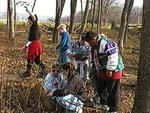
Beginning a graveyard restoration, regardless
of how run-down, should begin with documenting the yard. Documentation
of the yard in its present state is essential. This would include
photographic and textual recording, as well as mapping the site.
Making changes to the graveyard from its present condition is
a serious undertaking, even if it is in a bad state of deterioration.
It is imperative that a record of its present status in time be
documented and also any subsequent changes. We have chosen to
do this by videotaping our activities. This could also be done
via slides or black and white prints.
In order to save some time and to aid in accuracy, determine if
any records of the graveyard already exist, such as a map, registry,
or epitaph transcription. These might be located at an associated
church, city or county records, or the local historical society.
Often, small historical societies take on as a project the recording
of city or county cemeteries and the inscriptions on the stones.
This work may have been done years ago or was not exhaustive,
particularly if the graveyard was in bad shape, but the records
can save time and serve as a cross reference for your own work.
Earlier transcriptions may help to decipher some very worn and
hard to read ones, although be careful of mistakes made earlier.
These should get extra attention and any mistakes corrected. Early
maps might indicate markers that are no longer visible or are
missing. Sometimes markers are relocated to the wrong place.

|
|
|
|
|
| Photographic Record |
|
|
|